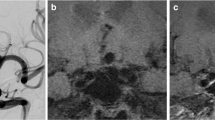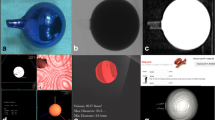Abstract
Intracranial aneurysms suffer various interactions between hemodynamics and pathobiology, and rupture when this balance disrupted. Aneurysm wall morphology is a result of these interactions and reflects the quality of the maturation. However, it is a poorly documented in previous studies. The purpose of this study is to observe aneurysm wall thickness and describe the characteristics of translucent aneurysm by analyzing clinical and morphological parameters. 253 consecutive patients who underwent clipping surgery in a single institute were retrospectively analyzed. Only middle cerebral artery aneurysms (MCA) which exposed most part of the dome during surgery were included. Aneurysms were categorized based on intraoperative video findings. Aneurysms more than 90 % of super-thin dome and any aneurysms with entirely super-thin-walled daughter sac were defined as translucent aneurysm. A total of 110 consecutive patients with 116 unruptured MCA aneurysms were included. Ninety-two aneurysms (79.3 %) were assigned to the not-translucent group and 24 (20.7 %) to the translucent group. The relative proportion of translucent aneurysm in each age group was highest at ages 50–59 years and absent at ages 30–39 and 70–79 years. There was a trend that translucent aneurysms were smaller in size (p = 0.019). Multivariate logistic analysis showed that translucent aneurysm was strongly correlated with height <3 mm (p = 0.003). We demonstrated that the translucent aneurysms were smaller in size and the aneurysm height <3 mm was related. These results may provide information in determining treatment strategies in patients with small size aneurysm.

Similar content being viewed by others
References
Meng H, Tutino VM, Xiang J, Siddiqui A (2013) High wss or low wss? Complex interactions of hemodynamics with intracranial aneurysm initiation, growth, and rupture: toward a unifying hypothesis. Am J Neuroradiol
Kadasi LM, Dent WC, Malek AM (2013) Colocalization of thin-walled dome regions with low hemodynamic wall shear stress in unruptured cerebral aneurysms. J Neurosurg 119(1):172–179
Elsharkawy A, Lehecka M, Niemela M et al (2013) Anatomic risk factors for middle cerebral artery aneurysm rupture: computed tomography angiography study of 1009 consecutive patients. Neurosurgery 73(5):825–837 discussion 836–827
Raghavan ML, Ma B, Harbaugh RE (2005) Quantified aneurysm shape and rupture risk. J Neurosurg 102(2):355–362
Costalat V, Sanchez M, Ambard D et al (2011) Biomechanical wall properties of human intracranial aneurysms resected following surgical clipping (irras project). J Biomech 44(15):2685–2691
Ingall T, Asplund K, Mahonen M, Bonita R (2000) A multinational comparison of subarachnoid hemorrhage epidemiology in the who monica stroke study. Stroke 31(5):1054–1061
Naggara ON, White PM, Guilbert F, Roy D, Weill A, Raymond J (2010) Endovascular treatment of intracranial unruptured aneurysms: systematic review and meta-analysis of the literature on safety and efficacy. Radiology 256(3):887–897
Wiebers DO, Whisnant JP, Huston J 3rd et al (2003) Unruptured intracranial aneurysms: natural history, clinical outcome, and risks of surgical and endovascular treatment. Lancet 362(9378):103–110
Sonobe M, Yamazaki T, Yonekura M, Kikuchi H (2010) Small unruptured intracranial aneurysm verification study: suave study, Japan. Stroke 41(9):1969–1977
Forget TR Jr, Benitez R, Veznedaroglu E et al (2001) A review of size and location of ruptured intracranial aneurysms. Neurosurgery 49(6):1322–1325 discussion 1325–1326
Dhar S, Tremmel M, Mocco J et al (2008) Morphology parameters for intracranial aneurysm rupture risk assessment. Neurosurgery 63(2):185–196 discussion 196–187
Asari S, Ohmoto T (1994) Growth and rupture of unruptured cerebral aneurysms based on the intraoperative appearance. Acta Med Okayama 48(5):257–262
Steiger HJ, Aaslid R, Keller S, Reulen HJ (1989) Strength, elasticity and viscoelastic properties of cerebral aneurysms. Heart Vessels 5(1):41–46
Kataoka K, Taneda M, Asai T, Kinoshita A, Ito M, Kuroda R (1999) Structural fragility and inflammatory response of ruptured cerebral aneurysms. A comparative study between ruptured and unruptured cerebral aneurysms. Stroke 30(7):1396–1401
Frosen J, Piippo A, Paetau A et al (2004) Remodeling of saccular cerebral artery aneurysm wall is associated with rupture: histological analysis of 24 unruptured and 42 ruptured cases. Stroke 35(10):2287–2293
Sherif C, Kleinpeter G, Mach G et al (2014) Evaluation of cerebral aneurysm wall thickness in experimental aneurysms: comparison of 3t-mr imaging with direct microscopic measurements. Acta Neurochir (Wien) 156(1):27–34
Ujiie H, Tamano Y, Sasaki K, Hori T (2001) Is the aspect ratio a reliable index for predicting the rupture of a saccular aneurysm? Neurosurgery 48(3):495–502 discussion 502–493
Weir B (2002) Unruptured aneurysms. J Neurosurg 97(5):1011–1012 discussion 1012–1013
Weir B (2002) Unruptured intracranial aneurysms: a review. J Neurosurg 96(1):3–42
Allcock JM, Canham PB (1976) Angiographic study of the growth of intracranial aneurysms. J Neurosurg 45(6):617–621
Conflict of interest
The authors report no conflict of interest concerning the materials or methods used in this study or the findings specified in this paper.
Author information
Authors and Affiliations
Corresponding author
Rights and permissions
About this article
Cite this article
Song, J., Park, J.E., Kim, H.R. et al. Observation of cerebral aneurysm wall thickness using intraoperative microscopy: clinical and morphological analysis of translucent aneurysm. Neurol Sci 36, 907–912 (2015). https://doi.org/10.1007/s10072-015-2101-9
Received:
Accepted:
Published:
Issue Date:
DOI: https://doi.org/10.1007/s10072-015-2101-9




